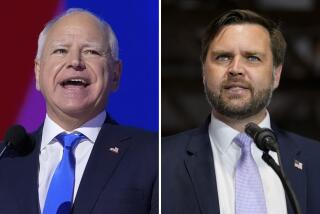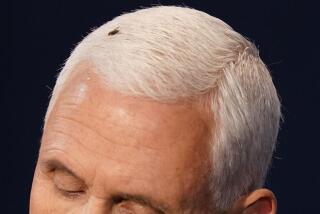Remember, don’t hit below the belt
- Share via
The presidential candidates apparently agree on only two things -- their opponent is an evildoer, and televised debates should be as animated as watching David Blaine inside a 6-ton block of ice, minus the drama of the whole bathroom question.
To that end, the Bush and Kerry camps have signed a “Memorandum of Understanding” that establishes rules for the debates. The 32-page document restricts camera angles, dressing room size, room temperature -- and that’s just the beginning.
The candidates square off for the first time tonight. God forbid an actual debate should break out.
Memorandum of Understanding: The candidates shall enter the stage upon a verbal cue by the moderator after the program goes on the air, proceed to center stage, shake hands, and proceed directly to their positions behind their podiums.
Commentary: Scuttles Kerry’s original plan to come on stage aboard a swift boat.
All members of the debate audiences will be instructed by the moderator before the debate goes on the air and by the moderator after the debate goes on the air not to applaud, speak, or otherwise participate in the debate by any means other than by silent observation.
Prevents audience members from shouting out answers to Bush, while simultaneously keeping Teresa Heinz Kerry from hollering, “Shove it!”
No props, notes, charts, diagrams, or other writings or other tangible things may be brought into the debate by any candidate.
A loophole may permit Bush to write sound bites on his forearms, which are expected to be variations on his main talking point: “I’m George W. Bush and I approved this message.”
The candidates may not ask each other direct questions, but may ask rhetorical questions.
A bid to maintain civility, but it is still unclear if the provision would prohibit questions such as: “I know you are, but what am I?” and “How can you be so stupid?”
At no time during these debates shall either candidate move from their designated area behind their respective podiums.
Meant to discourage Kerry from windsurfing and Bush from reenacting his aircraft carrier landing.
The Commission shall provide for an audible cue announcing the end of time for each of the candidate’s responses.
The actual “time’s up” signal is still undecided, but at press time it appears Chuck Barris will bang a gong for Kerry and Donald Trump will yell, “You’re fired!” to Bush.
Each candidate will be permitted to have one predesignated staff member in the wings or in the immediate backstage area during the debate.
Lurking behind the curtain: On Kerry’s side, President Bill Clinton. On Bush’s, Monticore the tiger.
There will be no filming, taping, photography, or recording of any kind (except by that candidate’s personal photographer) allowed.
Translation? Neither candidate wants to contribute to the “Fahrenheit 9/11” sequel.
The backdrops behind each candidate shall be identical.
The Republicans originally proposed Bush be flanked by 10,000 American flags, while Kerry stand behind a large, talking waffle.
The Commission shall use best efforts to maintain an appropriate tempera- ture according to industry standards for the entire debate.
The Bush camp insisted on this deliberately vague language when it got wind of Kerry’s plan to unfavorably compare the President’s IQ to temperature in the room. In anticipation of the remark, Republicans intend to keep debate auditoriums at 181 degrees.
Each candidate shall have a dressing room available of adequate size so as to provide private seclusion for that candidate and adequate space for the staff the candidate desires to have in this area. The two (2) dressing rooms shall be comparable in size and in quality and in proximity and access to the debate stage.
Kerry lost considerable respect among the “liberal Hollywood elite” when the senator dropped his demand for a “bigger, shinier” trailer than Bush. What next, they cried, second billing to Gary Coleman?
*
Martin Miller and Roy Rivenburg can be reached at [email protected].
More to Read
Get the L.A. Times Politics newsletter
Deeply reported insights into legislation, politics and policy from Sacramento, Washington and beyond. In your inbox three times per week.
You may occasionally receive promotional content from the Los Angeles Times.










